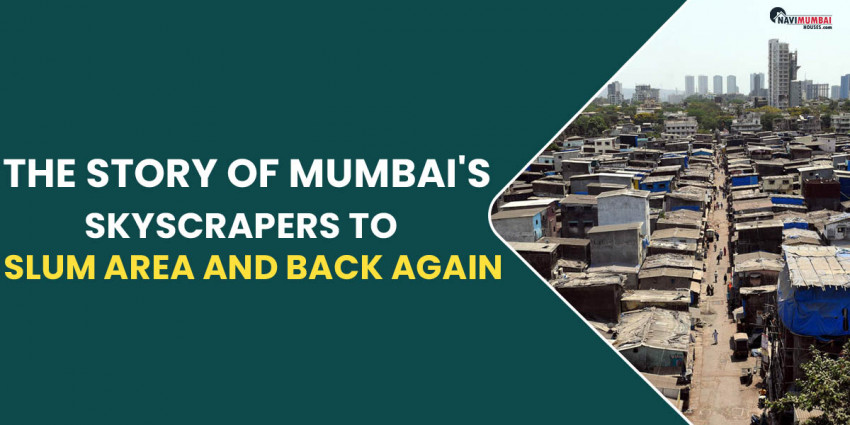
Ghettos and tall designs are genuine the two terms that are most often utilized when people and experts talk about how metropolitan organizations make. The ghettos' desperation and raised designs' sterility are the awful deformities of city organizers and neighborhood. They like close by regions that are for the most part around blended in with homes, affiliations, working conditions, and public solaces. This makes us contemplate Mumbai, India's cash related center point. Mumbai has correspondingly been hinted as the Mayanagri or the City of Visionaries, among different names. It is reasonable why this city offers such a gigantic aggregate that might be of some value, from walks around Marine Voyage all over evening to getting a charge out of chai while watching the tempest from your showcase. Mumbai, anyway, shows itself in two undeniable ways. No matter what Mumbai's gleaming beach front apexes, rich locales, and engaging nightlife, the city's awful genuinely found in its ghetto region.
Is it likely that you are looking for 2bhk pads in mumbai?
In a generally brief timeframe, this city has loosened up to bewildering sizes. It is home to undeniably the most extravagant property upgrades for the planet, such Antilia, yet it is comparably home to one of the most incredible ghetto areas. Mumbai is home to the remarkable and most noteworthy ghetto on the planet, Dharavi. Inside the Mumbai city, which is involved a tireless length of smoky ways and open sewers, it almost has every one of the reserves of being a conjured up universe.
A huge piece of occupants of this city of dreams live in homes that are confused for human home. Ghettos and unlawful settlements have bounced up all over. Nonetheless, why are such vast occupants in the country's monetary focus expected to live in chawls and ghettos, such poor lodging structures? How did Mumbai's metropolitan scene develop such a conspicuous qualification? In addition, what parts support its endless ascending to clear quality over an extended time? Might we at some point research.
Ghettos and Chawls of Mumbai
Mumbai has a wide grouping of shocking dwelling plans considering need. Chawls and ghettos are two instances of odd dwelling techniques that should be visible as starting with one side of the planet then onto the next. The deter in these thickly populated regions advances social ways to deal with behaving like public resting, public washing, as well as the sharing of public solaces like water and latrine work environments.
These lodging structures, which date back to the mid 1800s when England controlled India, have changed to oblige a rising group in a compelled space. Considering the improvement of a doable public transportation structure in the nineteenth 100 years, post-wild Mumbai went through a fast urbanization.
With such speedy extension, the city has seen a wide assortment of lodging choices emerge, including tents, chawls, lofts, homes, and tall plans.
Staying District for Mumbai Tenants
Mumbai's geology is portrayed by a darkness of regional endpoints because of the city's unconstrained duplication of both evidently and casually made properties.
This can be anything from a six-foot stretch of usable napping space to a questionable residency circumstance shared by three families that are "leasing" an equivalent room. Jhopad-patties give way to unlawful, just semi-extremely amazing developments, which thusly give way to deal with dark tops. These plans are connected with chawls and different sorts of poor lodging on another range. Condos ensured and leased by individuals from the gigantic working class are organized over this level, while the rich and very rich own the pads and houses that are organized above them.
Ghetto settlements for the most part incorporate a blend of lodging choices, including tents, mud and cover houses, and block and significant plans. Every unit is by and large under eight by eight feet, and there are no common solaces open. Since the squashed that need stable lodging may be found any place, neighborhood lines don't exactly as expected groupings these homes.
Individuals from lower money related classes and strays who live in metropolitan locales looking for work regularly stay in ghettos. Notwithstanding, even whenever they've obtained some cash and can endure moving out, various as much of the time as possible keep on dwelling in their claustrophobic ghetto homes. During the pioneer time, these promotion libbed transient homes were basically tracked down near the areas of business. In any case, as India acquired its opportunity, these domains long term moved to less ideal metropolitan districts, such a no man's land or boggy spots near railroad tracks.
Normal Mumbai's Typical Lodging
Mumbai was given to the Head of Britain by the Portuguese in 1661. The East India Affiliation was given a rent on the city by the Leader of Britain two years in a little while, in 1668, so it very well may be utilized for tries. Mumbai around then was isolated into three segments:
• Bombay Island was home to the key palace.
• The increase of Mahim.
• Parel, Mezagaon, Varlu, Matunga, Vadadla, Colaba, Naigaum, and Dharavi are the eight towns that make up this area.
The palace that at first remained on Bombay Island was uprooted in 1715 by a fortress wall considering the island's expanding individuals.
The Remarkable Fire of 1803 squashed a lot of Indian dealer property, and the city was worked on because of the rising infringement of townhouses into the post district. The Indians were moved to the area north of the fort wall considering this fixing up.
In addition, it incited the English "refining" neighborhood bunches from the fortress region and obliging movement past the post walls. Toward the north of the walled city, the English gathered material plants. Chawls filled quickly during the 1850s and during the Cotton Effect of 1860 considering this kind of industrialization. These plants might be found in locales like West Parel, Tardeo, and Lalbagh, which are at this point a piece of Mumbai's focal business region. Mumbai's creating spot and lower classes broadened revenue for private and business land because of the city's extending producing locale.
Since they couldn't tolerate dwelling in additional ideal spots, laborers from lower-and normal families were obliged to live in less valuable districts, which were as every now and again as possible abutting undertakings. This structure incited the settlement of various transient plant laborers in unsuitable locales, accomplishing bound areas inside the city. This is today known as the Mumbai ghetto region.
Staying in Post-Trailblazer Mumbai for Normal trained professionals
Because of the inflow of vagabonds and removed people that occurred in free India not long after The Ensuing Remarkable Clash, the absence of lodging soon rose to the chief spot on the summary of the country's most genuine issues. The typical number of tenants in a home space has move to six by 1951. Settlements in ghetto areas filled in as the issue's outward portrayal.
The improvement of the ghettos got no worry from the English government. In spite of the state making genuinely little undertaking, the economy was maintained by unpretentious work, making it a helpful game plan. The Indian government explained that it would take out ghettos and override them with "standard" abiding for the middle class whenever the country achieved an open door. Better lodging for ghetto inhabitants and permitting them to live always on their lawfully or unlawfully pursued and associated land keep on clashing with each other.
Mumbai's ghettos' district and attributes
Maybe of the most stuffed and rich city in India is Mumbai. Certainly the best ghettos on earth combine Dharavi, Mankhurd-Govandi belt, Kurla-Ghatkopar belt, Dindoshi, as Well as the Bhandup-Mulund ghettos. These ghettos' major credits are:
• High velocity of Despondency
• A High Joblessness Rate
• Metropolitan debasement for a colossal degree;
• Great spots for Social Ills, For example, Terrible way of behaving, Unlawful prescription use, and so on.;
• High Occasion of Mental Issues, Collapse, and so forth.;
• low cash related status of neighboring people;
• deficient construction working environments;
• Issue of Outrageous Horror
• Nonattendance of drinkable water;
• Not Giving Fundamental Clinical advantages;
• unsanitary and obfuscated regular parts;
• Low degree of presence or second rate personal satisfaction.
Top Genuine variables about Mumbai's Ghettos
Mumbai has been drawing in to find additional room since the pioneer time period. Mumbai is circumnavigated through ocean on three sides. The strain is stretched out by the constant development of voyagers from different pieces of India who have been attracted to the city by its managing cash related potential outcomes. Because of a shortfall of reasonable solace and a constant expansion in metropolitan land costs, formal home is far off for by far most of these explorers.
Interfacing Dharavi is the Bandra Kurla Befuddling, possibly of Asia's for the most part unreasonable corporate concentration. Because of its region to Mumbai's two fundamental nation train lines, individuals could really show up working quickly. Dharavi is home to countless flourishing exclusive organizations that produce top notch ceramics, plastic, calfskin things for convey, and twisted around garments. It is an obviously different, multi-ethnic, and multi-serious settlement. One of the most fit ghettos in all of India, Dharavi has tutoring pace of 69%, as per Wikipedia.
Most ghetto homes are feeling the loss of every single confidential washroom and establishments. The rarely remained mindful of public working environments and expensive water sold by merchants should be paid for by inhabitants. Several washrooms in Mumbai's ghettos need power, while others need running water. There are a ton of ghetto homes with lacking passages.






